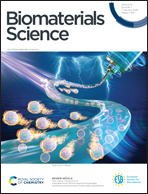Supramolecular pyrrole radical cations for bacterial theranostics†
Abstract
Bacterial infections with emerging resistance to antibiotics require urgent development of antibacterial agents with new core skeletons. Recently, a series of antibacterial agents have been reported based on positively charged organic groups, such as ammonium, guanidine, and phosphonium groups, which can selectively bind and destroy negatively charged bacterial membranes. To achieve imaging-guided precise antibacterial therapy, these positively charged organic groups usually require further decoration with imaging modalities, such as fluorescence. However, most fluorophores with electron-closed shell structures usually suffer from tedious synthetic procedures for preparation. We herein prepare a series of positively charged and deep-red fluorescent supramolecular pyrrole radical cations (P˙+–CB[7]) based on the simple mixing of pyrroles and CB[7] in water under air. The readily available deep-red fluorescent P˙+–CB[7] can not only be used for selective imaging and killing of live Gram-positive bacteria with excellent biocompatibility, but also for imaging of dead Gram-negative bacteria killed by drugs and in vivo monitoring of phagocytosis of bacteria by innate immune cells in zebrafish. It is believed that the deep-red fluorescent pyrrole radical cations as a new core skeleton are promising in bacterial theranostics.



 Please wait while we load your content...
Please wait while we load your content...